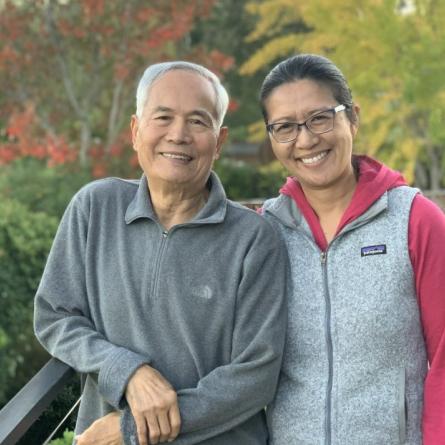Being a caregiver for a parent means helping in different ways and playing different roles. For Aimee Yairi, it started when her dad told her that he was having a lingering cough in early 2021. The fear was that he had caught COVID. His primary care physician continued ordering x-rays for her father and prescribing different medications for pneumonia, asthma, and GERD—but resisted sending him to a specialist. Aimee advocated for her father to get a CT scan. And that was when the 7 cm tumor was discovered.
Despite her father living in the major metropolitan area of Honolulu, Aimee knew that he had to seek specialized care and time was of the essence. Within one week of the CT scan results, Aimee’s father was on a plane from Hawaii to seek care in the San Francisco Bay Area, where Aimee and her siblings lived. It was May of 2021 when he was officially diagnosed with non-small cell lung cancer (NSCLC).
Aimee’s First Steps in Being a Caregiver for a Parent
Upon arriving in the San Francisco Bay Area, Aimee encouraged her father to seek care at a local academic center and then subsequently, a second opinion at a different nearby academic center. This was the first step in her caregiving journey, and she became the primary caregiver and advocate for her parent.
“The first few months after the diagnosis were taxing and so intense. I was very overwhelmed but incredibly grateful for the support network I found,” says Aimee.
Never did Aimee expect her professional background in the biotech and pharmaceutical area, focused on oncology, would help her with the medically focused role she would take on in her father’s care. She knew that connecting with lung cancer organizations like LUNGevity would help her learn how to support her dad in many additional ways.
Her key responsibilities were finding the right doctors, communicating with medical staff because her father is a non-native English speaker, researching treatment options and clinical trials, joining support groups, finding patient resources, managing doctor’s visits, and helping her dad understand treatment options, risks, and possible outcomes, including the role of comprehensive biomarker testing.
This is how they found the EGFR-mutation, specifically exon deletion 19, in his lung cancer tissue. And with this new information, they could offer him a more tailored plan including targeted treatment, rather than traditional chemotherapy, with or without radiation.
“One thing I want to get across about treatment today is that lung cancer is diverse and heterogeneous. There are many types of lung cancer and many treatment options. But, you need to know the type of lung cancer you’re dealing with. Comprehensive biomarker testing gives you that information so that you may have the option of a treatment designed to treat your type of lung cancer,” says Aimee.
Changing Roles as Treatment Changes
At this point, Aimee’s role of being a caregiver for a patient expanded. She went from managing her father’s doctor appointments to learning about the treatment options he had moving forward.
“It’s important people make the decisions that are best for them and their families. At the time of diagnosis, my father was 78 years old, and quality of life was important to him as well as to our family. At the same time, I wanted to know as much as possible about treatment options for this type of lung cancer, including what was not yet standard of care and specifically what clinical trial options were there for my dad. I knew my dad had choices. I just had to figure out what choices he had and to share them with him so that he could make an informed decision,” says Aimee.
This is an example of how being a caregiver for a parent is different for everyone. It’s about working as a team where each person takes on different roles to form a strong unit. Aimee knew her strengths, such as understanding and being able to navigate a complicated healthcare system and the complexities of oncology care in the community vs. academic settings.
She also knew to ask his healthcare teams about clinical trials and learned of a local one for patients with EGFR-positive lung cancer. The rationale for the trial sounded reasonable and other data appeared promising. And it would be significantly more convenient if he stayed with her in the San Francisco Bay Area while undergoing treatment.
Caregivers Need Support Too
But no caregiver journey is easy. While Aimee focused on helping her father with his cancer treatment, she also had a young daughter who needed support with remote learning due to COVID. Additionally, Aimee went through her own medical issues at the same time, including abdominal surgery and a broken foot.
No caregiver can give 100% of themselves to someone else. And that’s okay.
“You will feel like you’re giving 200% and you’re not alone. But know that life is not static. This too shall pass. One of my father’s “cancer buddies” told me that the first 6 months after diagnosis is the hardest. That was certainly our experience,” says Aimee.
Today, Aimee’s dad is over a year out from his open thoracotomy and continues to stay on a targeted treatment as maintenance therapy plan. He is now home in Honolulu and continues to rake the leaves under his mango trees and look forward to visits with his grandchildren.
Aimee has stayed in contact with the lung cancer community, and she continues to support her father by managing his healthcare team appointments and other needs. As her dad continues his lung cancer journey, Aimee continues her journey by giving back to the lung cancer community through outreach programs, like the LifeLine Support Partner program, that help connect her to other newly diagnosed patients and caregivers.
“The journey, especially at the beginning, can be so scary and disorienting. I hope to be able to lend an ear and share some of the wisdom others kindly gave to us during our darkest times.”

